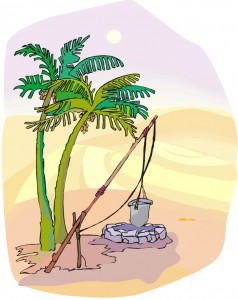Tag Archives: Healing
New Video: Understanding Divine Healing from a Whole Bible Perspective
In this video, we explore the Torah-covenantal perspective on divine healing and move through the Psalms, Prophets, Gospels and Epistles to give a whole Bible or holistic view of divine healing. With the Torah as the foundation, we learn how divine healing relates to our privileges and responsibilities as born-again disciples of Yeshua.
Understanding Divine Healing From a Whole Bible Perspective
A couple of weeks ago, someone reading this blog asked me if I had any teachings on divine healing. I went back over the hundreds of teachings I have given in written and video form and to my surprise I found none. This was in spite of the fact that over the years I have prayed for many hundreds of sick people, and seen many miraculous healings including in my own body.
This study doesn’t cover all there is to say on the subject of divine healing, but it’s a start. I’ll do another teaching soon to pick up where this one leaves off. So stay tuned…!
My thanks to the brother who asked the question! May this be a blessing someone for YHVH’s glory.
Natan
The foundation for understand the concept of biblical healing is found in the Torah (the books of the law) and the Tanakh (the Old Testament). Without this foundational and a Hebraic perspective on healing, it is impossible to understand the holistic nature of healing as presented in the Scriptures. This is why we will start our study of healing from the Torah and progress to the end of the Bible.
In the following study, we will quote a Bible passage relating to the subject of healing, and then comment on it afterwards.
Exod 15:26, And said, If thou wilt diligently hearken to the voice of Yehovah thy Elohim, and wilt do that which is right in his sight, and wilt give ear to his commandments, and keep all his statutes, I will put none of these diseases upon thee, which I have brought upon the Egyptians: for I am Yehovah that healeth (Heb. rapha) thee.
Yehovah Rapha is one of YHVH Elohim’s covenant names. Rapha is a Hebrew word that means “to heal, make healthful” and can refer to Elohim, a healer or physician and involves being healed from individual distress, national hurts or defects.
YHVH’s covenantal promise of healing still stands today and is for his people—the saints (Eph 2:12). All of YHVH’s promises through Yeshua are yes and amein (2 Cor 1:20). YHVH promises to heal his people, but eventually everyone will die and then face YHVH’s judgment seat (Heb 9:27). Some people will be healed in this lifetime, while others will be healed when they receive their glorified bodies at the resurrection of the dead. Healing in the ultimate sense occurs when our old bodies die and we receive our new, resurrected and glorified bodies (1 Cor 15:50–56).
When we obey YHVH’s commands, we place ourselves in his river of life. Blessings and not curses come our way. When we go against his commandments, then the curses of sin automatically come upon us (Gen 2:17; Deut 28:1–68; Ezek 18:4; Rom 6:23). For generations our forefathers have violated YHVH’s commands, which is sin, and have Continue reading
Leaving the Bitterness of Egypt and Experiencing Healing in the Wilderness
Exodus 15:27, From Egypt to Elim to provision in the wilderness. In this portion of Scripture, we see a prophetic picture of what new believers must go through when leaving enslavement to Pharaoh (Satan) and coming out of Egypt (the world).
After leaving Egypt, Pharaoh pursued the Israelites not wanting to lose any of his subjects. YHVH then led the Israelites through the Red Sea, a picture of baptism for the remission of sins.
The Israelites then murmured against YHVH because of the bitter waters of Marah, which they were unable to drink. Moses, a prophetic picture of Yeshua, healed the waters when he cast a tree (a picture of Yeshua’s death on the cross) into the waters making them sweet and potable. This story shows us that we must put off the bitterness, unforgiveness, anger and fear of the carnal man before we can expect to receive a blessing from YHVH, and healing in our lives.
From there, the children of Israel came to the desert oasis of Elim where YHVH nourished them in a most refreshing way. Elim is a prophetic picture of coming into a bit of heaven on earth and the provisions of YHVH in the midst of our wilderness journey called life after having overcome our bitterness of past sin through the cross of Yeshua.
Immediately after this, YHVH began reigning manna down on the Israelites—a picture of Yeshua, the bread of life. This whole story teaches us that when we finally overcome the sins of bitterness and complaining through the power of Yeshua’s death, we can experience healing, physical nourishment, refreshment along with ongoing supernatural provision for our spiritual journey toward the Promised Land of YHVH’s kingdom.
New Video: Need Help? Stay in the River of Life!
New Video: Want healing? Stop eating garbage!
Yeshua in the War Zone — A Template for Ministry
Mark 1–3
It is interesting to note the order of events as Yeshua was launching his ministry. He was about to enter a war zone!
After John baptized Yeshua and he received his heavenly empowerment, he first went through a spiritual boot camp before stepping onto the battlefield of public ministry. Once in the “war,” it’s worth noting where the battle lines fell.
- His spiritual boot camp was the wilderness where he fasted for forty days and nights to get his body, soul and spirit, and his mind, will and emotions in sync with the will of his Father in heaven (Mark 1:12–15).
- His first battle was an internal one. The devil tested him in three areas: his body, soul and spirit, or, to put it another way, the lust of the flesh, the lust of the eyes and the pride of life (Mark 1:13). After overcoming himself and submitting to the will of his Father, he was now ready to launch into the war zone of public ministry.
- His mission was to preach the message of the gospel of the kingdom of Elohim and repentance from sin (i.e. Torahlessness, 1 John 3:4; Mark 1:14–15).
- Next he chose his cadre of spiritual warriors — his “army”— the twelve disciples (Mark 1:16–20).
- Where better to start proclaiming the gospel message than in the local synagogue on the Sabbath (Mark 1:21)? After all, the religious folks there should be overjoyed to hear this good news, fresh message from heaven. Right? Continue reading




